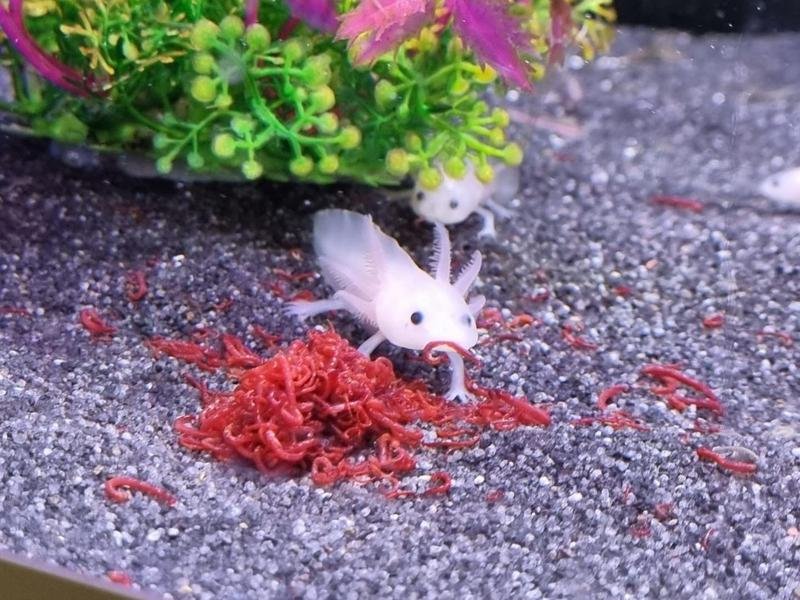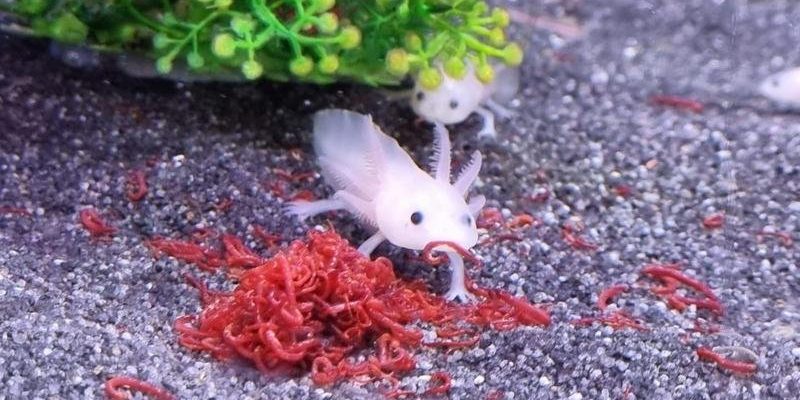
You might be surprised to learn that axolotls are not picky eaters, but their diet is primarily carnivorous. Think of them as the ultimate underwater predators, scooting around in their watery homes, looking for tasty treats. Their hunting style is rather unique, so let’s explore how they find food and what exactly goes on their menu.
What Do Axolotls Eat?
When it comes to a balanced diet, axolotls have specific preferences. They are mainly carnivorous, which means they love to munch on other living creatures. Here’s a look at some of their favorite foods:
- Worms: These slimy treats are a big hit among axolotls. They can devour earthworms or specialized worms made for aquarium pets.
- Small Fish: Small fish, especially those that swim slowly, make for an easy meal. Axolotls can catch them with a little stealth and speed!
- Crustaceans: Tiny shrimp and similar critters are excellent sources of protein for these little hunters.
- Pellets: Special pellets designed for axolotls or aquatic amphibians can provide balanced nutrition that keeps them healthy.
In their natural habitat, axolotls primarily eat insects and small invertebrates. If you’re keeping one as a pet, make sure to provide a varied diet to keep them happy and healthy. It’s a lot like feeding a toddler—variety is key!
How Do Axolotls Hunt?
So, how do these quirky creatures go about snagging their food? Here’s the thing: axolotls rely on a combination of stealth, speed, and what I like to call “the surprise factor.” They might not have the agility of a fish, but they’ve got their own tricks.
Axolotls use their keen sense of smell to detect food. When they sense a potential meal nearby, they can stealthily approach. They tend to sit still, almost like a cat waiting to pounce. Once they spot their target, they use powerful suction to draw food into their mouths. It’s quite an elegant process!
Their gills also play a role in hunting. While they use their sense of sight and smell primarily, their external gills allow them to take in more oxygen, enabling them to stay active in the search for food.
The Role of Color and Camouflage
Did you know that the appearance of an axolotl can assist in its hunting? Axolotls often have a blend of colors that help them to blend into their environment. This natural camouflage makes it easier for them to sneak up on potential prey.
For example, those with darker hues are less likely to be spotted against a muddy bottom or among rocks and plants. This allows them to get close enough for a successful hunt. Just think of them as underwater ninjas, expertly using their natural coloring to go unnoticed.
Feeding Habits: Frequency and Quantity
When it comes to how often axolotls should eat, moderation is essential. In their natural environment, they hunt on an as-needed basis, which may vary day to day. However, pet axolotls might need a bit more structure.
Generally, adult axolotls can be fed every 2-3 days. Young ones, on the other hand, require more frequent meals—usually every day or every other day.
Always remember to adjust the portion size based on their age and size. A good rule of thumb is to provide food that is roughly the size of their head. This ensures they can easily consume it without any issues.
What Happens if They Don’t Get Enough Food?
You might be wondering what could happen if an axolotl doesn’t eat enough. Like any living creature, if they’re not getting enough nutrients, it can lead to serious problems.
A malnourished axolotl might experience stunted growth or weakened immune systems, making them more susceptible to diseases. In extreme cases, they could stop eating altogether, leading to more severe health complications.
If you notice your axolotl hasn’t eaten in a while or looks lethargic, it’s crucial to reassess their diet and habitat. Make sure they’re comfortable, and not stressed, and that their water conditions are optimal.
Feeding an axolotl might seem simple, but understanding their dietary needs can make a world of difference in keeping them healthy and happy. From worms to tiny fish, these unique creatures are quite the efficient hunters.
By following a balanced diet and paying attention to their feeding habits, you’ll ensure your axolotl remains a thriving part of your underwater world. Remember, it’s not just about what the axolotl eats; it’s also about how they hunt and interact with their environment, making them truly special pets.
So, whether you’re a seasoned axolotl keeper or just starting out, knowing what they eat and how they hunt will equip you for a fruitful journey in care. Happy axolotl parenting!

